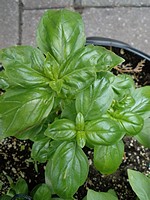What Is Horseradish
Horseradish is a hardy perennial plant grown mostly for its roots. It is a zesty member of the mustard family.
Horseradish has a long white root, and large oblong leaves that make it attractive planted at the back of perennial borders and garden beds.
The pungent root of the horseradish plant is what’s most commonly eaten.
The horse radish plant blooms in early summer with masses of small white blooms on 2 to 3 foot high stems. The blossoms of the horseradish plant are pleasantly fragrant.
Latin name: Armoracia rusticana
Planting and Growing Horseradish
Horseradish, once planted, should last for years in your garden. The exception being if you live in an area with extremely cold winters, or year-round summers.
Start horseradish plants by planting a horseradish root about 12 inches deep. Use a root about 8 or 9 inches in length.
Before planting, deeply cultivate the soil in early spring. Add compost or manure to the soil. Then, plant the horseradish roots about 12– 18 inches apart.
Keep the area weeded to give your horseradish the best chance of establishing itself in your garden.
Horseradish will return each year, and the clump will spread via underground shoots. Any horseradish root un-harvested will sprout back into a new plant the following year.
It is rare that you will need to re-purchase horseradish once you have initially planted it. Even small pieces of the root left behind in the soil will produce another plant.
Exceptions:
1. If you live in an area so cold that horseradish roots will not survive through the winter or
2. If you live in an area that is too hot, as horseradish requires a period of cold dormancy.
In these cases, grow horseradish as an annual.
As a guideline, horseradish grows extremely well in plant hardiness zone 5, and will tolerate weather conditions from plant hardiness zones 2 through 9.
Horseradish likes moist soil and full sun. Horseradish is a very adaptable plant though, and I found that it grows perfectly fine in a partially sunny area of my garden.
Once established, horseradish requires very little care. I took a root of horseradish from my mother about 15 years ago, and my horseradish clump is still going strong.
Horseradish can become invasive in some gardens. If this is the case in your garden, be sure to carefully dig out all sections of root in the area you don’t want more horseradish plants.
Harvesting and Storing Your Horseradish
Harvest your horseradish in late fall – October and November. You can keep harvesting your horseradish until the ground freezes.
Alternately, you can also harvest your horseradish in early spring, before there is much new growth.
Then, there is my mother’s harvesting schedule. She just digs up some horse radish whenever she wants to use it – early spring for Easter morning, throughout the summer (even when the horseradish plant is blooming), and throughout the fall until the ground freezes solid. Works for her.
Most of the root growth occurs later in the growing season. So, until your horseradish patch is well established, I suggest waiting until the fall to harvest your horseradish.
Store your horseradish roots packed in dry sand in a cool dark location — cold cellar or garage work well.
Horseradish will also keep in the crisper drawer in the refrigerator.
To your herb garden success,
Herb Garden Gal
Copyright © 2011 www.HerbGardenGal.com. All rights reserved.
_________
Want to use this article in your Ezine or Website? You can, as long as you include the complete article and the Copyright information.











